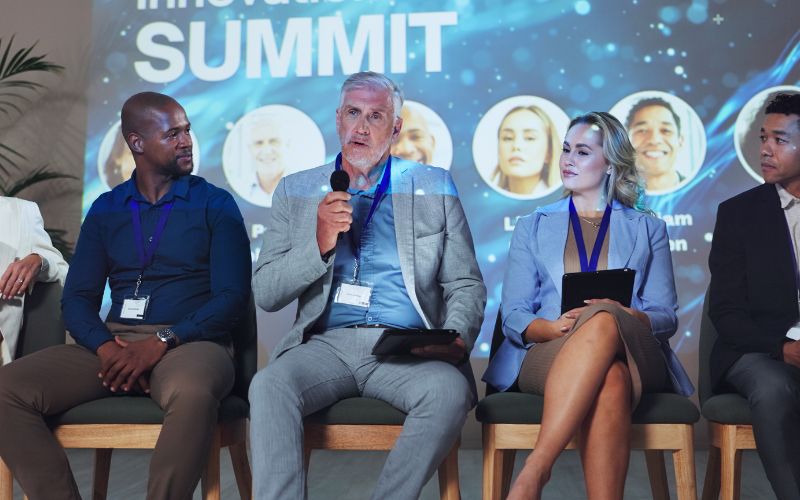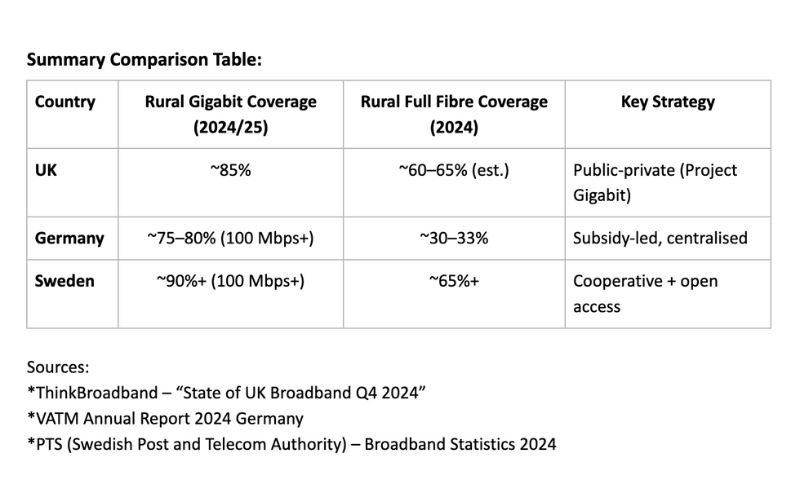Euroroute Network Solutions
Rural Fibre Insights from Sweden, Germany, and the FTTH Conference 2025
As the UK drives forward with Project Gigabit, closing the rural digital divide remains one of the broadband industry’s greatest challenges. While fibre-to-the-premises (FTTP) availability is accelerating, rural coverage still lags behind urban areas. At the FTTH Conference 2025 in Amsterdam, some of Europe’s most advanced markets offered valuable lessons in how public-private collaboration, innovation, and community engagement are reshaping rural connectivity. In particular, Sweden and Germany showcased two different but complementary approaches with potential learnings for the ongoing UK rural rollout.

Sweden’s Model: Local Ownership and Open Access
Sweden has long been a frontrunner in rural fibre connectivity, and one key reason is its cooperative approach. Many rural fibre networks are owned and operated by local cooperatives. These are community-led groups that pool funding from residents, businesses, and government grants. These networks are open access, meaning any ISP can offer services over them, driving competition and keeping prices low.
One standout example is Stokab, Stockholm’s municipal fibre network, which leases dark fibre to any provider. This model reduces duplication, improves affordability, and encourages innovation in services as well as with infrastructure.
What could this mean for the UK?
Rather than leaving rural deployments entirely to the private sector, UK ISPs could partner with councils or community groups to co-invest in shared infrastructure. Additionally, Ofcom could mandate open access conditions on publicly funded networks to ensure long-term competition and consumer choice. For ISPs, Euroroute’s no-touch CPE deployment ensures that routers arrive fully pre-configured to the end user, supporting local initiatives with scalable, hands-off installation that reduces cost and complexity for ISP rural rollouts.
Germany’s Approach
Germany is investing €12 billion to connect underserved regions, prioritising areas with less than 100 Mbps. A key strategy has been tiered subsidies, offering greater financial support to the hardest-to-reach areas, such as Bavaria’s mountainous regions.
Structured Subsidies and Centralised Coordination
Another strong point is Germany’s centralised digital portal, which allows municipalities to apply for funding and track project progress. This helps streamline bureaucracy and align stakeholders across government and private sectors. While Germany is still behind the UK in rural access they also learned a lesson from an early over-reliance on vectoring (copper-based) technologies which previously delayed full-fibre adoption. As German policymakers prioritised full-fibre infrastructure over interim copper-based solutions, fibre coverage accelerated significantly, reaching 33% of households by late 2024, up from just 19% in early 2022. Germany also has a national goal of gigabit coverage for all households by 2030. Euroroute’s product range includes Wi-Fi 6 and Wi-Fi 7-ready CPE, including AVM FRITZ!Box and Kontron Iskratel Innbox models. These devices are built for long-term performance, supporting next-gen broadband services without the pitfalls of legacy tech.

FTTH Conference 2025 Takeaways
Beyond funding and policy, the FTTH Conference spotlighted deployment innovation as a key lever in rural broadband acceleration. Techniques like micro-trenching, aerial fibre, and pre-connectorized cabling are significantly cutting time and labour costs, by as much as 30% in some pilot projects.
The conference also highlighted the growing importance of sustainability in fibre rollout. From recycling unused cabling to deploying energy-efficient hardware, operators are under pressure to align with EU green infrastructure goals. Our CPE solutions come with eco-conscious packaging, and our Cloud ACS platform (powered by AVSystem) supports remote provisioning, monitoring, and firmware updates, eliminating truck rolls and lowering environmental impact.
What UK ISPs Can Take Away
The UK has unique regulatory and market dynamics, but several actionable insights from Europe stand out:
Adopt Open Access Models: Partner with infrastructure providers to extend reach while reducing capital expenditure.
Invest in Deployment Innovation: Embrace fibre-laying techniques that save time and money in rural terrain.
Explore Community Partnerships: Work with local authorities or groups to co-invest and boost adoption.
Focus on Sustainability: Incorporate green practices in both device choices and deployment logistics.
Avoid Short-Term Fixes: Skip legacy tech and invest directly in future-ready FTTH solutions.
Learnings From Europe to Shape Rural UK Broadband
Sweden’s cooperative networks and Germany’s structured gigabit funding both demonstrate that rural fibre success takes alignment, innovation, and smart execution. As the UK pushes towards nationwide gigabit coverage by 2030, ISPs have a real opportunity to build on these proven strategies. With Euroroute’s no-touch deployment, premium CPE, and remote management tools, ISPs can deliver high-performance, low-cost, and low-carbon broadband solutions tailored for rural markets. Contact us today to learn how we can support your next rural expansion project.

